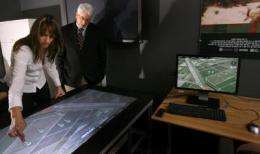Sandia researchers merge gaming, simulation tools to create models for border security

With funding from the Department of Homeland Security's Customs and Border Protection (CBP), researchers at Sandia National Laboratories have developed a high-fidelity simulation and analysis program that aids policy and decision-makers tasked with making key procurements and funding choices.
The Borders High Level Model (HLM) uses a serious gaming platform known as Ground Truth, a force-on-force battle simulation tool called Dante, and the work of several collaborating organizations.
"There's a lot of debate going on in the government concerning the technology and infrastructure investments that need to be made along the border," explained Jason Reinhardt, who serves as the Borders HLM project manager at Sandia. "How much fence do we need? What kind of fence? What is the right mix of border personnel and technology? How can sensors, vehicles and other technical equipment most effectively be used? With Borders HLM, CBP officials can simulate their defensive architectures, accurately measure their performance and start to answer these difficult questions."
Ground Truth, initially funded through internal Sandia investments in 2007, is a gaming platform originally designed to prepare decision makers and first responders for weapons of mass destruction/weapons of mass effect (WMD/WME) attacks in metropolitan areas. Developed by Sandia computer scientist and Borders HLM principal investigator Donna Djordjevich, the software provides a virtual environment where users can play through various scenarios to see the effects of their decisions under the constraints of time and resources.
For the Borders HLM project, the Ground Truth software has been integrated into bottom-projected touch surface table. On this game surface, users can see "people" moving across the border terrain, observe CBP "personnel" respond to incidents and essentially control those movements and "apprehend" suspects. Users can also view a leader board of sorts that shows how many suspects have been apprehended, the dollar amount spent implementing the chosen architecture and other metrics that matter to CBP decision-makers.
Dante, also part of the Borders HLM platform, is a force-on-force battle simulation tool built on the well-known Umbra simulation framework developed and introduced in 2001 by Sandia researchers.
The work also builds from another Sandia borders project from the mid-2000s (focused on the impact of new detection technology at ports of entry) and capitalizes on a range of existing Sandia capabilities, including the Weapons of Mass Destruction Decision Analysis Center (WMD-DAC), the National Infrastructure Simulation and Analysis Center (NISAC, a joint Sandia and Los Alamos National Laboratory program) and even the lab's expertise in robotics.
According to Reinhardt and Djordjevich, there were a number of technical challenges in integrating a mature modeling technology like Dante with a newer gaming technology like Ground Truth.
"We needed to create real-time control for the user, and our current capabilities weren't built to do that," Reinhardt said. "There's also the fact that we're modeling 64 square miles of border, and we need to do so at a pretty high fidelity," added Djordjevich, who pointed out that Ground Truth's terrain was originally developed at a fixed, small scale. To help overcome some of the barriers, Sandia has looked to some important collaborators.
The University of Utah provided a technology, Visualization Streams for Ultimate Scalability (ViSUS), which allows researchers to progressively stream in terrain and imagery data and minimize data processing requirements, an important consideration given that HLM requires many gigabytes of data. For its part, Happynin Games, an iPhone/mobile game development company, developed the 3-dimentional artwork and the characters found in the simulations. Sandia, acting as the systems integrator, then put all the pieces together, presented the Borders HLM product to CBP and demonstrated how it would allow them to go through all the steps of the "engagement analysis cycle."
"We learned that the border patrol agents and CBP decision-makers need a tool that offers a common view of the problems they face," said Reinhardt. "With our high level model, they can play through various scenarios and see how people, technology and other elements all interact. Then, later, they can go back and do a baseline analysis and dig into the details of why certain architectures and solutions aren't working as well as they should." CBP personnel can then play the game again with a recommended solution, and the end users can critique and tweak it to their liking.
With additional funding and the right kind of collaborations, Djordjevich said, more robust features could be added to make Borders HLM even more valuable to CBP and other potential customers. The current version, for instance, only deals with individual border crossers, so it doesn't capture crowd behaviors. Other sensor types, such as radiation detectors or even airborne equipment, could also be added.
Reinhardt says the future of the Borders HLM tool will likely depend on the direction in which CPB chooses to go with its border operations. "Our high-level models tool will likely change the way CBP conducts its business, and it will probably have a real long-term impact on how large expenditures are justified or reputed on and around the nation's borders."
Provided by Sandia National Laboratories

















